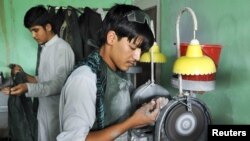In order to deprive the Taliban of profits from smuggled exports of the prized gemstone lapis lazui, Afghanistan plans to create its own bourse to stone to precious blue stone, mined and traded for millennia in the Hindu Kush Mountains.
The Taliban increasingly uses criminal enterprises such as gemstone smuggling and heroin laboratories and kidnapping to finance their activities.
Gemstone smuggling costs Afghanistan roughly $100 million a year, more than the total export of commodities like coal and industrial minerals like talc, according to the country’s mining minister.
"It's a big issue for the people of Afghanistan, because they are losing their property to groups of terrorists who on one side are stealing our property and on the other side are strengthening their terrorist group. So it's a lose-lose situation," said mines minister Daud Saba.
It would be difficult to halt the smuggling of emeralds, rubies, jade, and other materials, he said, but the trade of lapis lazuli can be more easily controlled; the stone, famed for its unique properties, hails from a single mine -- Sar-i-Sang -- in northern Afghanistan.
The Afghan government aims to have a bourse up and running in Kabul by mid-2016 for the stone, which would come with a government certificate.
"We have the monopoly on that type of lapis. That stone has a signature," Saba said. "And then any other lapis with no certificate should be banned by the international community, as they have done with blood diamonds."
Blood diamonds are diamonds mined in conflict areas and sold to fund wars. The United Nations launched a certification program in 2003 in an effort to ban trade in conflict diamonds. Since then, blood diamonds now comprise less than 1 percent of the diamond trade, according to industry sources.
With reporting by Reuters






